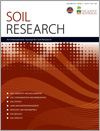Calcium oxalate is found in plants and soils as insoluble minerals which may represent dead ends in the recycling of Ca in some forests and in the soils of arid regions. Is this a problem for the Ca nutrition of forests? Or is it an opportunity to sequester C in the soils of arid regions?

Soil Research
Volume 56 Number 5 2018
SR17282Assessment of efficacy of biocides in different soil types for use in sorption studies of low molecular weight organic compounds
The abiotic protection of dissolved organic carbon in soils may be an important regulator of C cycling, but its mechanistic study is hampered by biological activity. Here, we investigated the use of biocides to reduce biological activity in batch sorption experiments. We found that although in sandy soils minimal biocide concentrations are effective, in clay-rich soils high concentrations of toxic biocidal compounds are required for complete microbial inhibition, and not using biocides could compromise findings where sorption of dissolved organic carbon is studied.
SR17330Speciation of nickel and enzyme activities in fluvo-aquic soil under organic amendments treatment
Nickel is a toxic element which may lead to serious consequences when accumulated in soil. Humic acid and cow dung are effective for reducing the environmental risk of nickel in soil, as well as improving the environmental quality of nickel-polluted soil. The results of the present study will provide data and information for the prevention of soil heavy metal pollution.
SR17221Stocks, composition and vulnerability to loss of soil organic carbon predicted using mid-infrared spectroscopy
Quantifying agricultural management impacts on soil organic carbon content and composition is important to sustaining productivity and identifying impacts on greenhouse gas emissions. Measuring and monitoring soil organic carbon can be costly; however, the spectroscopic analyses defined can provide a cost effective alternative. With adequate calibration and testing, soil spectroscopic analyses will allow the identification and promotion of agricultural practices capable of maintaining or building soil carbon.
SR17148Assessing the vulnerability of organic matter to C mineralisation in pasture and cropping soils of New Zealand
Soil organic carbon is a valuable soil resource but is vulnerable to loss through changes in management or environmental perturbations. We assessed the vulnerability of soil organic carbon to loss using two approaches. Our results suggest that water extractable carbon can provide an estimate of the mineralisable pool of carbon in a soil.
SR17278Why copper and zinc are ineffective in reducing soil urease activity in New Zealand dairy-grazed pasture soils
Ammonia (NH3) produced from fertiliser urea and animal urine, and emitted to the atmosphere has negative economic (reduced production) and environmental (pollution of water bodies and detriment to human health) impacts. We tested the use of Cu and Zn to reduce NH3 losses by reducing the activity of the enzyme responsible for NH3 production in dairy-grazed pasture soils. We found that in organic matter-rich dairy-grazed pasture soils, Cu and Zn had no effect on this enzyme and these metals cannot be used to reduce NH3 losses.
SR18049Simultaneous measurement of exchangeable Al and other cations in acidic soils
Aluminium toxicity limits plant production over much of the acidic soils of south-western and eastern Australia. We compared different methods for measuring Al held by soils, including a method not generally used for Al, and found that the methods were in general agreement. This means that for most acidic soils we can analyse for all of the nutrient cations in soil, and toxic Al, with one extraction method.
SR18007Soil quality change 50 years after forestland conversion to tea farming
TOC abstract: Land-use changes in Iran have been more rapid in the past few decades. The effects of land-use change during the past 50 years from forest to tea farms on soil quality indicators (cumulative rating and Cornell Comprehensive Assessment of Soil Health) were investigated in the Guilan Province in northern Iran. Results indicate soil quality in the natural forest land was higher than in the tea farm study sites, and organic matter decreased and consequently soil structural properties degraded as a result of deforestation.
SR18062Iron oxides in fractured quartz – development and evolution of iron sandstone layers in the Kinshasa area, DR Congo
Iron sandstone layers at a locality in the DR Congo display a unique feature, in the form of quartz grains crossed by surface-parallel cracks that are filled with iron oxides. This occurrence was studied to understand its development, concluding that it involves opening of surface-parallel cracks when an exposed iron sandstone layer was subjected to temperature fluctuations, followed by reprecipitation of dissolved iron oxides in a setting with alternating moisture conditions. The presence of filled cracks of this type allows recognition of former exposed surface levels.
SR17333In situ ATR-FTIR spectroscopic study of the co-adsorption of myo-inositol hexakisphosphate and Zn(II) on goethite
The co-adsorption of organic phosphates and heavy metals on minerals may affect the adsorbed amounts and speciation of each other, which can further influence their transport and fate. The present study aims to investigate the co-adsorption mechanism of phytate and Zn(II) on goethite. The results provide new insights into the mutual effect of organic phosphates and heavy metals in relation to their mobility and transport in soil and sediment environments.
SR17220Comparing traditional and digital soil mapping at a district scale using residual maximum likelihood analysis
We demonstrate how digital soil mapping can be used to identify Pedoderms. This was done using a clustering algorithm and ancillary data acquired from an airborne passive remote sensing gamma-ray spectrometer and ground-based reconnaissance survey of electromagnetic induction data. The approach can be expanded to larger areas as both data sets are now routinely becoming available across larger areas.



